Automated Mapping of Transportation Embankments in Fine-Resolution LiDAR DEMs
Abstract
1. Introduction
2. Materials and Methods
2.1. Embankment Mapping Algorithm
2.1.1. Seed Selection
2.1.2. Parameter Derivation
2.1.3. Region Growing
2.1.4. Algorithm Implementation
2.2. Study Sites
2.3. Algorithm Validation
3. Results
3.1. Algorithm Performance
3.2. Classification
4. Discussion
4.1. Embankment Classification
4.2. Embankment Removal
4.3. Algorithm Limitations
5. Conclusions
Author Contributions
Funding
Institutional Review Board Statement
Informed Consent Statement
Data Availability Statement
Acknowledgments
Conflicts of Interest
References
- Lindsay, J.B.; Dhun, K. Modelling surface drainage patterns in altered landscapes using LiDAR. Int. J. Geogr. Inf. Sci. 2015, 29, 397–411. [Google Scholar] [CrossRef]
- Lunardi, P. Embankment Formed by Preformed Collaborating Assemblable Elements, in Particular for Road or Railway Constructions, and Process. U.S. Patent No. 5,482,408, 9 January 1996. [Google Scholar]
- Wu, W.; Berhe, T.G.; Ashour, T. Embankments and dams. In Modern Earth Buildings; Woodhead Publishing: Cambridge, UK, 2012; pp. 538–558. [Google Scholar]
- Lidberg, W.; Nilsson, M.; Lundmark, T.; Ågren, A.M. Evaluating preprocessing methods of digital elevation models for hydrological modelling. Hydrol. Process. 2017, 31, 4660–4668. [Google Scholar] [CrossRef]
- Mäkinen, V.; Oksanen, J.; Sarjakoski, T. Automatic determination of stream networks from DEMs by using road network data to locate culverts. Int. J. Geogr. Inf. Sci. 2018, 33, 291–313. [Google Scholar] [CrossRef]
- Duke, G.D.; Kienzle, S.W.; Johnson, D.L.; Byrne, J.M. Improving overland flow routing by incorporating ancillary road data into Digital Elevation Models. J. Spat. Hydrol. 2003, 3. [Google Scholar] [CrossRef]
- Duke, G.D.; Kienzle, S.W.; Johnson, D.L.; Byrne, J.M. Incorporating ancillary data to refine anthropogenically modified overland flow paths. Hydrol. Process. 2006, 20, 1827–1843. [Google Scholar] [CrossRef]
- Thomas, I.A.; Jordan, P.; Shine, O.; Fenton, O.; Mellander, P.E.; Dunlop, P.; Murphy, P.N.C. Defining optimal DEM resolutions and point densities for modelling hydrologically sensitive areas in agricultural catchments dominated by microtopography. Int. J. Appl. Earth Obs. Geoinf. 2017, 54, 38–52. [Google Scholar] [CrossRef]
- Yu, F.; Harbor, J.M. The effects of topographic depressions on multiscale overland flow connectivity: A high-resolution spatiotemporal pattern analysis approach based on connectivity statistics. Hydrol. Process. 2019, 33, 1403–1419. [Google Scholar] [CrossRef]
- Zandbergen, P. Accuracy considerations in the analysis of depressions in medium-resolution lidar DEMs. Gisci. Remote Sens. 2010, 47, 187–207. [Google Scholar] [CrossRef]
- Lindsay, J.B. Efficient hybrid breaching-filling sink removal methods for flow path enforcement in digital elevation models. Hydrol. Process. 2016, 30, 846–857. [Google Scholar] [CrossRef]
- Stanislawski, L.; Brockmeyer, T.; Shavers, E. Automated road breaching to enhance extraction of natural drainage networks from elevation models through deep learning. Int. Arch. Photogramm. Remote Sens. Spat. Inf. Sci. Isprs Arch. 2018, 42, 671–678. [Google Scholar] [CrossRef]
- Florinsky, I.V.; Kuryakova, G.A. Influence of topography on some vegetation cover properties. Catena 1996, 27, 123–141. [Google Scholar] [CrossRef]
- Köthe, R.; Bock, M. Preprocessing of Digital Elevation Models–derived from Laser Scanning and Radar Interferometry–for Terrain Analysis in Geosciences. Proc. Geomorphometry 2009, 2, 155–161. [Google Scholar]
- McBratney, A.B.; Mendonça Santos, M.L.; Minasny, B. On digital soil mapping. Geoderma 2003, 117, 3–52. [Google Scholar] [CrossRef]
- Scull, P.; Franklin, J.; Chadwick, O.A.; McArthur, D. Predictive soil mapping: A review. Prog. Phys. Geogr. Earth Environ. 2003, 27, 171–197. [Google Scholar] [CrossRef]
- Hormese, J.; Saravanan, C. Automated Road Extraction from High Resolution Satellite Images. Procedia Technol. 2016, 24, 1460–1467. [Google Scholar] [CrossRef]
- Hu, X.; Tao, C.V.; Hu, Y. Automatic road extraction from dense urban area by integrated processing of high-resolution imagery and lidar data. Int. Arch. Photogramm. Remote Sens. Spat. Inf. Sci. 2004, 35 Pt B3, 288–292. [Google Scholar]
- Karnieli, A.; Meisels, A.; Fisher, L.; Arkin, Y. Automated Extraction and Evaluation of Geological Linear Features from Digital Remote Sensing Data Using a Hough Transform. Photogramm. Eng. Remote Sens. 1996, 62, 525–531. [Google Scholar]
- Lu, P.; Du, K.; Yu, W.; Wang, R.; Deng, Y.; Balz, T. A new region growing-based method for road network extraction and its application on different resolution SAR images. IEEE J. Sel. Top. Appl. Earth Obs. Remote Sens. 2014, 7, 4772–4783. [Google Scholar] [CrossRef]
- Quackenbush, L.J. A review of techniques for extracting linear features from imagery. Photogramm. Eng. Remote Sens. 2004, 70, 1383–1392. [Google Scholar] [CrossRef]
- Tupin, F.; Maitre, H.; Mangin, J.F.; Nicolas, J.M.; Pechersky, E. Detection of linear features in SAR images: Application to road network extraction. IEEE Trans. Geosci. Remote Sens. 1998, 36, 434–453. [Google Scholar] [CrossRef]
- Huang, X.; Cao, R.; Cao, Y. A Density-Based Clustering Method for the Segmentation of Individual Buildings from Filtered Airborne LiDAR Point Clouds. J. Indian Soc. Remote Sens. 2019, 47, 907–921. [Google Scholar] [CrossRef]
- Cormen, T.H.; Leiserson, C.E.; Rivest, R.L.; Stein, C. Introduction to Algorithms; MIT Press: Cambridge, MA, USA, 2009. [Google Scholar]
- Lindsay, J.B. WhiteboxTools User Manual. Available online: https://jblindsay.github.io/wbt_book/preface.html (accessed on 3 September 2020).
- Embankment Mapping.rs. Available online: https://github.com/jblindsay/whitebox-tools/blob/master/src/tools/terrain_analysis/embankment_mapping.rs (accessed on 29 April 2020).
- Ontario Ministry of Natural Resources and Forestry. User Guide Lidar Point Cloud (2016-18) LIO Dataset; Queen’s Printer for Ontario. 2019. Available online: https://geohub.lio.gov.on.ca/datasets/776819a7a0de42f3b75e40527cc36a0a (accessed on 3 September 2020).
- Chicco, D.; Jurman, G. The advantages of the Matthews correlation coefficient (MCC) over F1 score and accuracy in binary classification evaluation. BMC Genom. 2020, 21, 6. [Google Scholar] [CrossRef]
- Manning, C.; Raghavan, P.; Schütze, H. Introduction to Information Retrieval; Cambridge University Press: Cambridge, UK, 2008. [Google Scholar]
- Matthews, B.W. Comparison of the predicted and observed secondary structure of T4 phage lysozyme. Biochim. Biophys. Acta (BBA) Protein Struct. 1975, 405, 442–451. [Google Scholar] [CrossRef]
- Cramer, H. Mathematical Methods of Statistics; Princeton University Press: Princeton, NJ, USA, 1946. [Google Scholar]
- Arun, P.V. A comparative analysis of different DEM interpolation methods. Egypt. J. Remote Sens. Space Sci. 2013, 16, 133–139. [Google Scholar] [CrossRef]
- Bater, C.W.; Coops, N.C. Evaluating error associated with lidar-derived DEM interpolation. Comput. Geosci. 2009, 35, 289–300. [Google Scholar] [CrossRef]
- Doucette, P.; Beard, K. Exploring the capability of some GIS surface interpolators for DEM gap fill. Photogramm. Eng. Remote Sens. 2000, 66, 881–888. [Google Scholar]
- Guo, Q.; Li, W.; Yu, H.; Alvarez, O. Effects of topographic variability and lidar sampling density on several DEM interpolation methods. Photogramm. Eng. Remote Sens. 2010, 76, 701–712. [Google Scholar] [CrossRef]
- Liu, X.; Zhang, Z.; Peterson, J. Evaluation of the performance of DEM interpolation algorithms for LiDAR data. In Proceedings of the 2009 Surveying and Spatial Sciences Institute Biennial International Conference: Spatial Diversity (SSC 2009), Adelaide, Australia, 28 September–2 October 2009; pp. 771–780. [Google Scholar]
- Setianto, A.; Triandini, T. Comparison of Kriging and Inverse Distance Weighted (Idw) Interpolation Methods in Lineament Extraction and Analysis. J. Appl. Geol. 2015, 5, 21–29. [Google Scholar] [CrossRef]
- Khaloo, A.; Lattanzi, D. Robust normal estimation and region growing segmentation of infrastructure 3D point cloud models. Adv. Eng. Inform. 2017, 34, 1–16. [Google Scholar] [CrossRef]
- Vo, A.V.; Truong-Hong, L.; Laefer, D.F.; Bertolotto, M. Octree-based region growing for point cloud segmentation. ISPRS J. Photogramm. Remote Sens. 2015, 104, 88–100. [Google Scholar] [CrossRef]
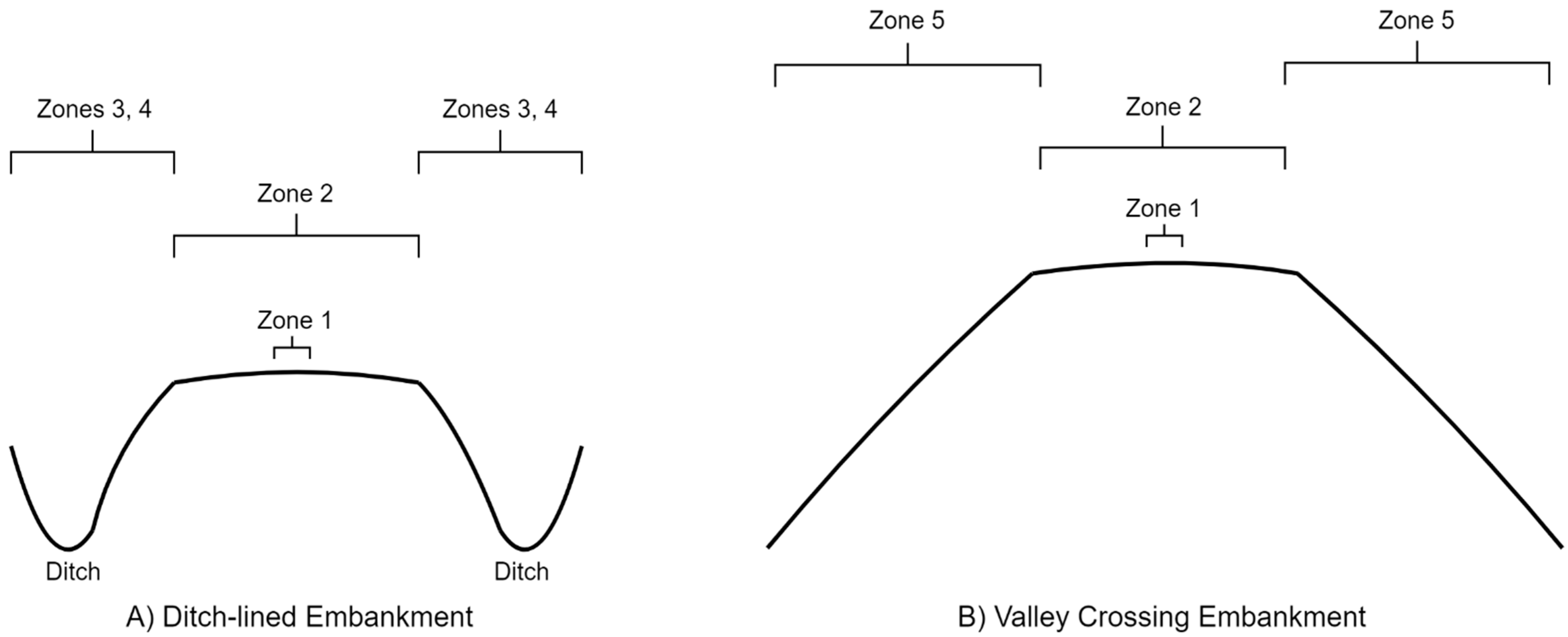
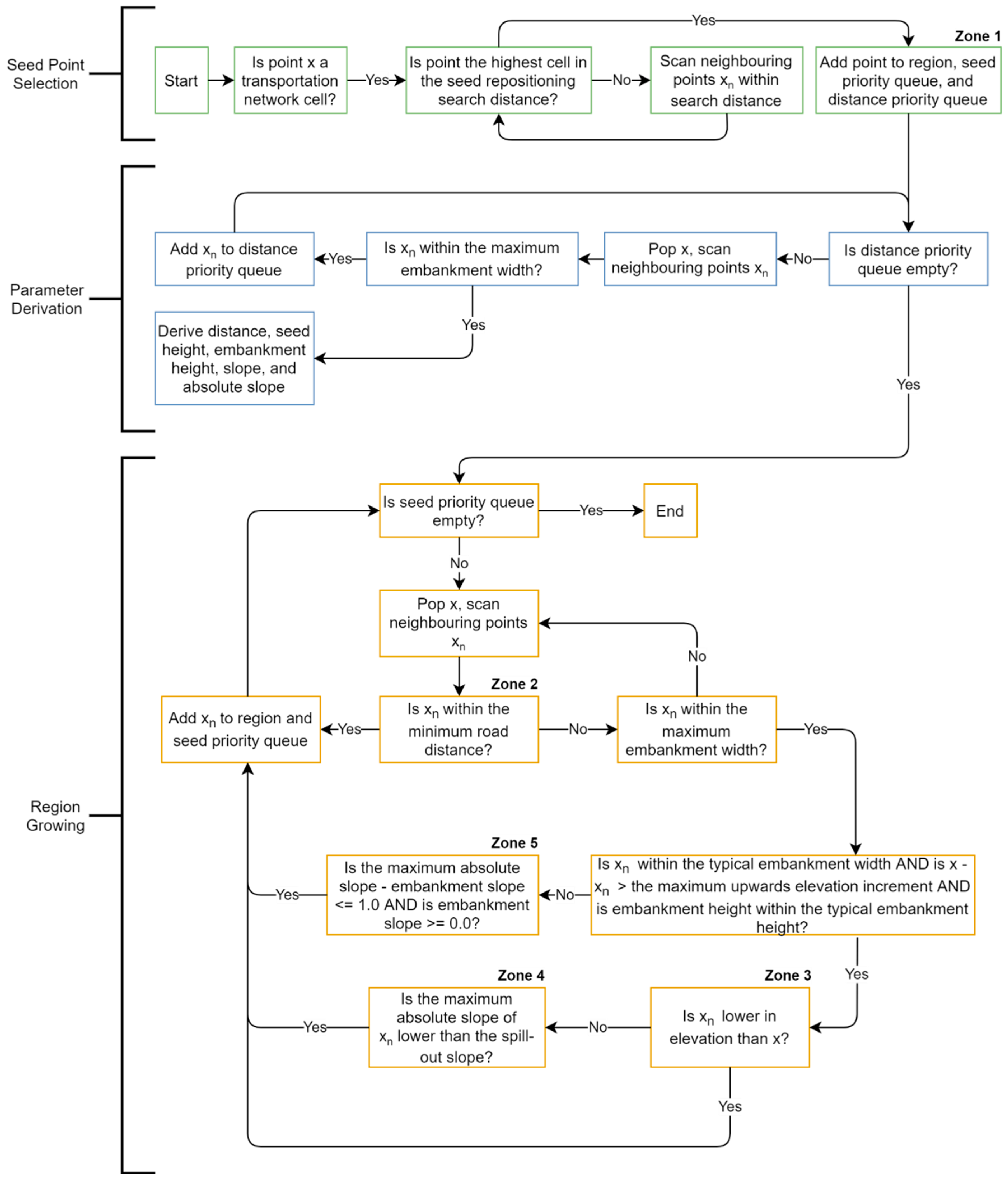
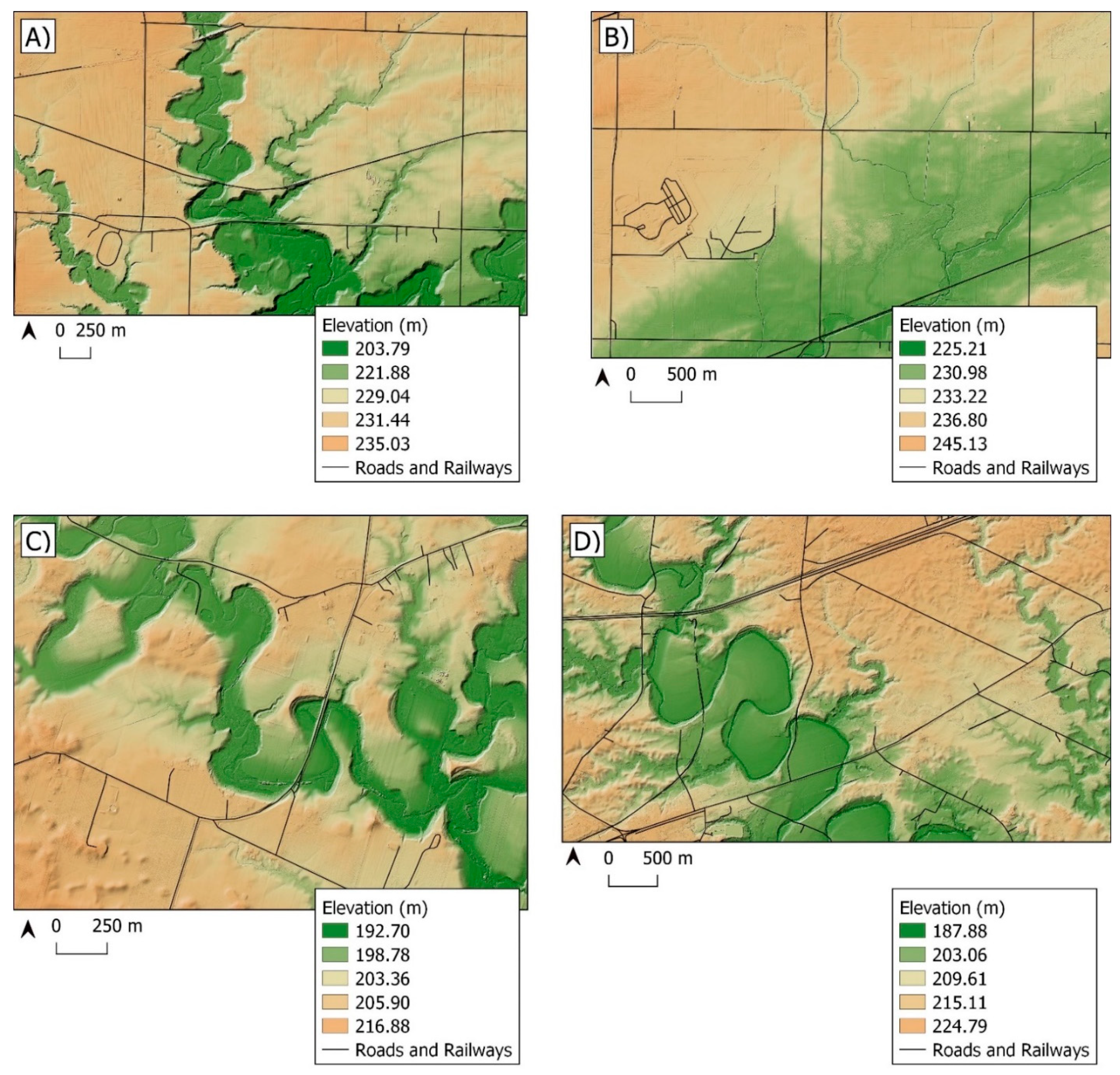
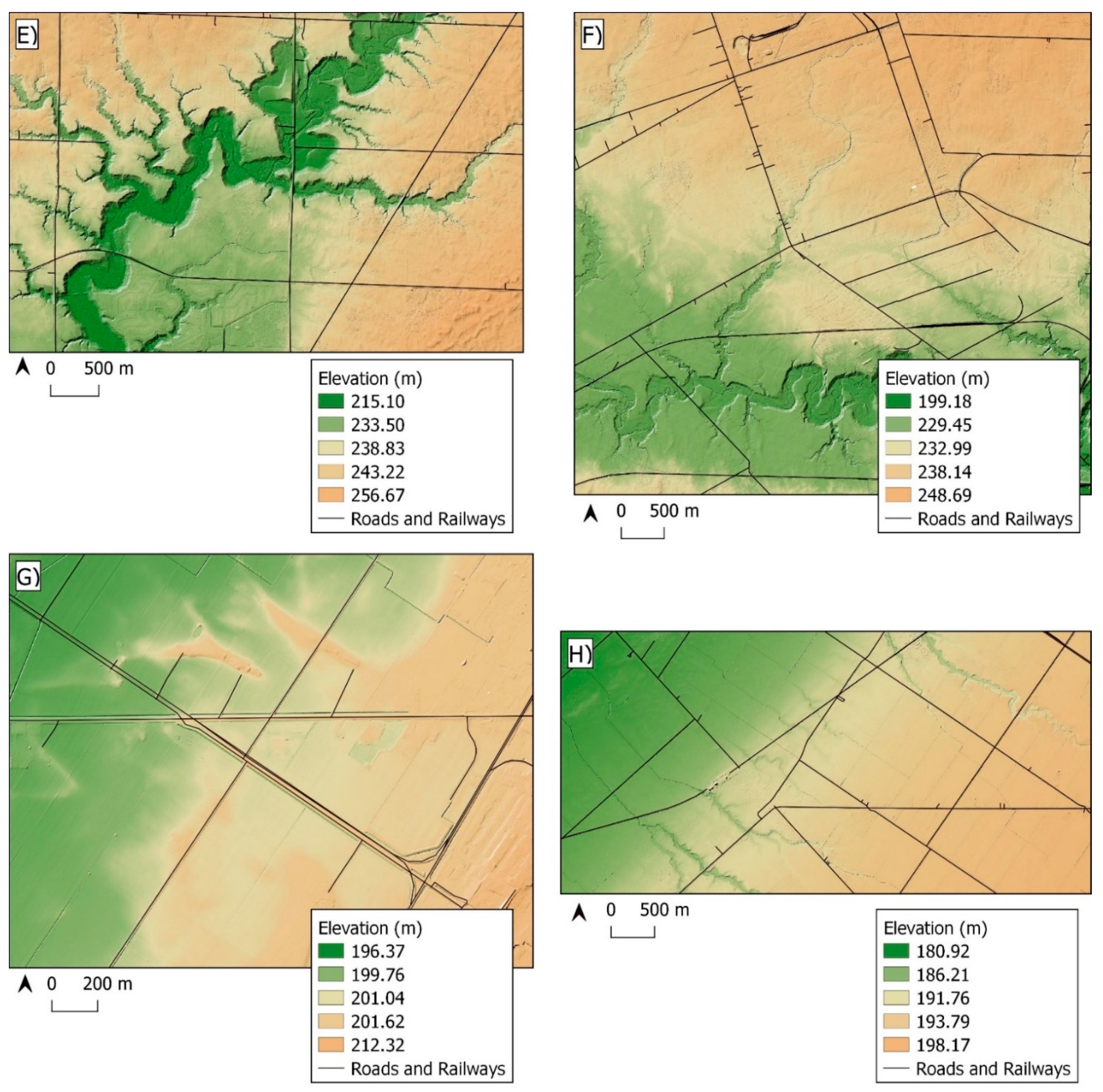
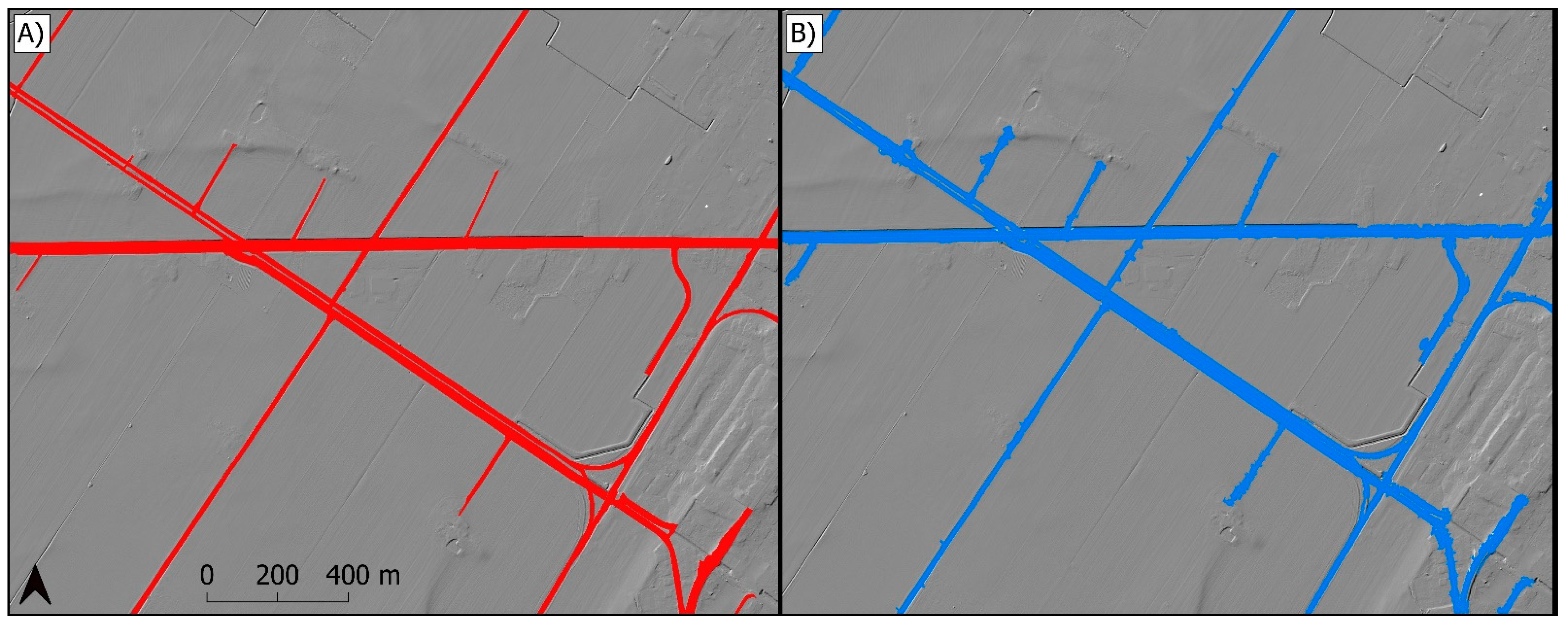
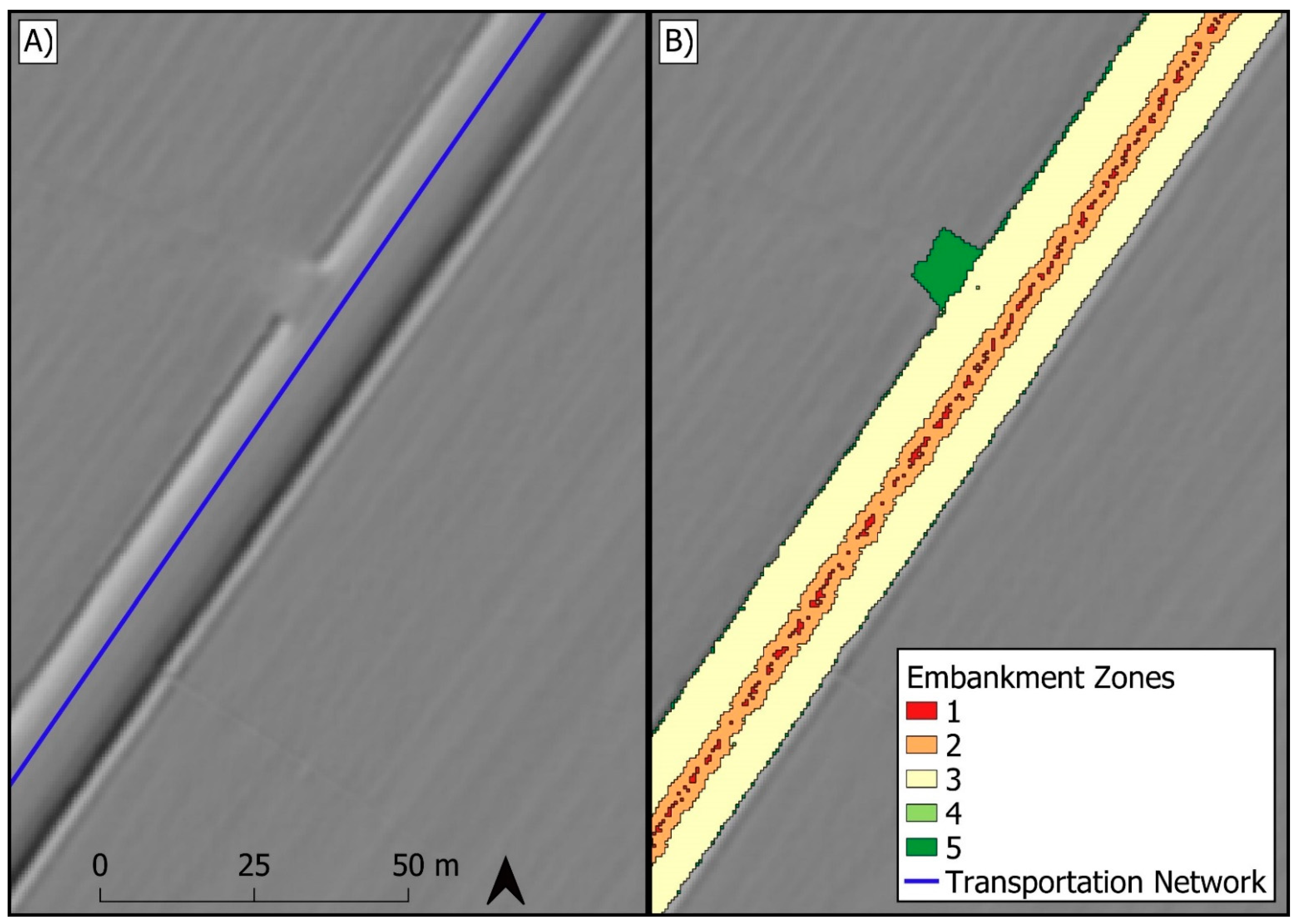

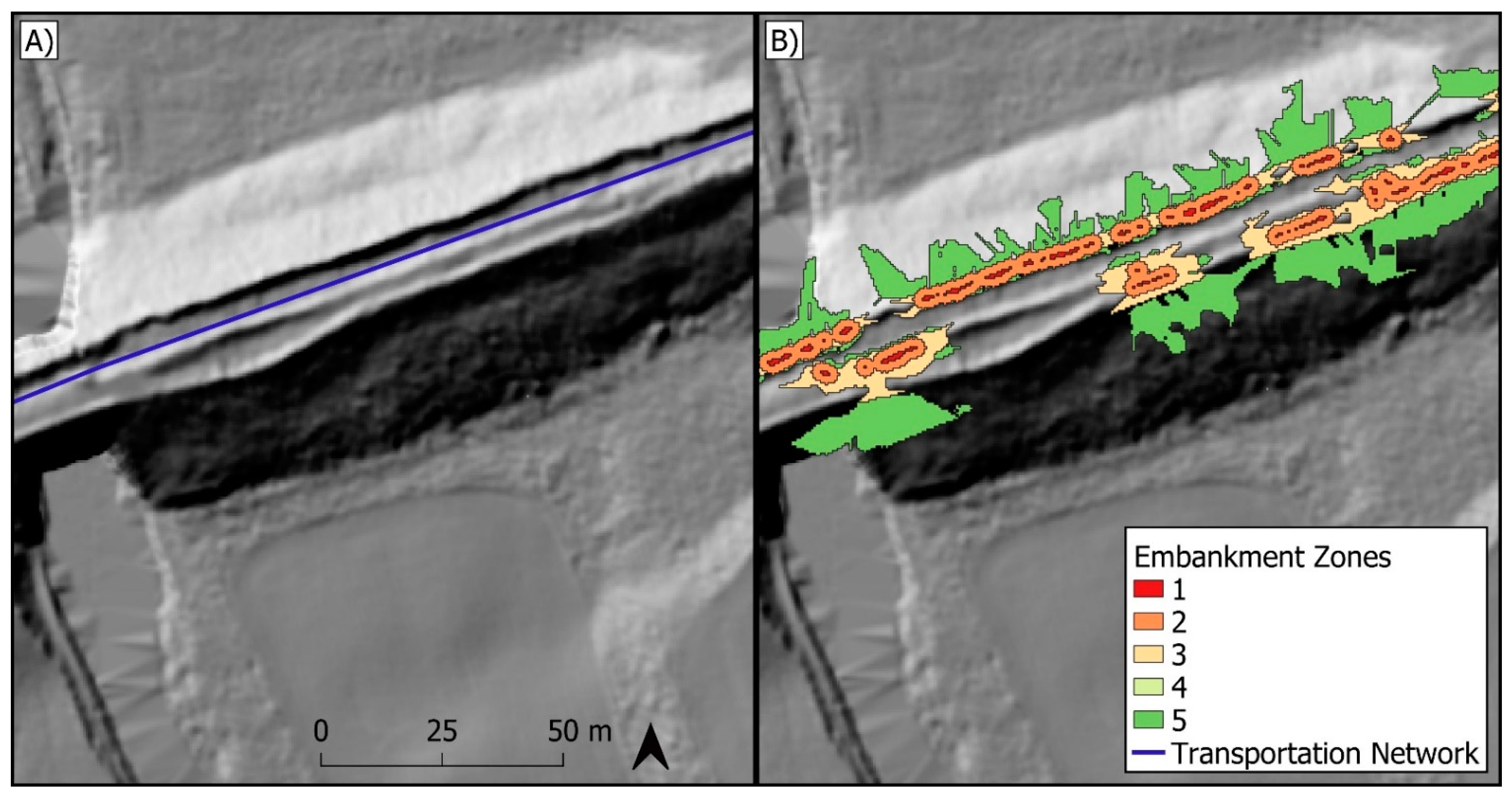
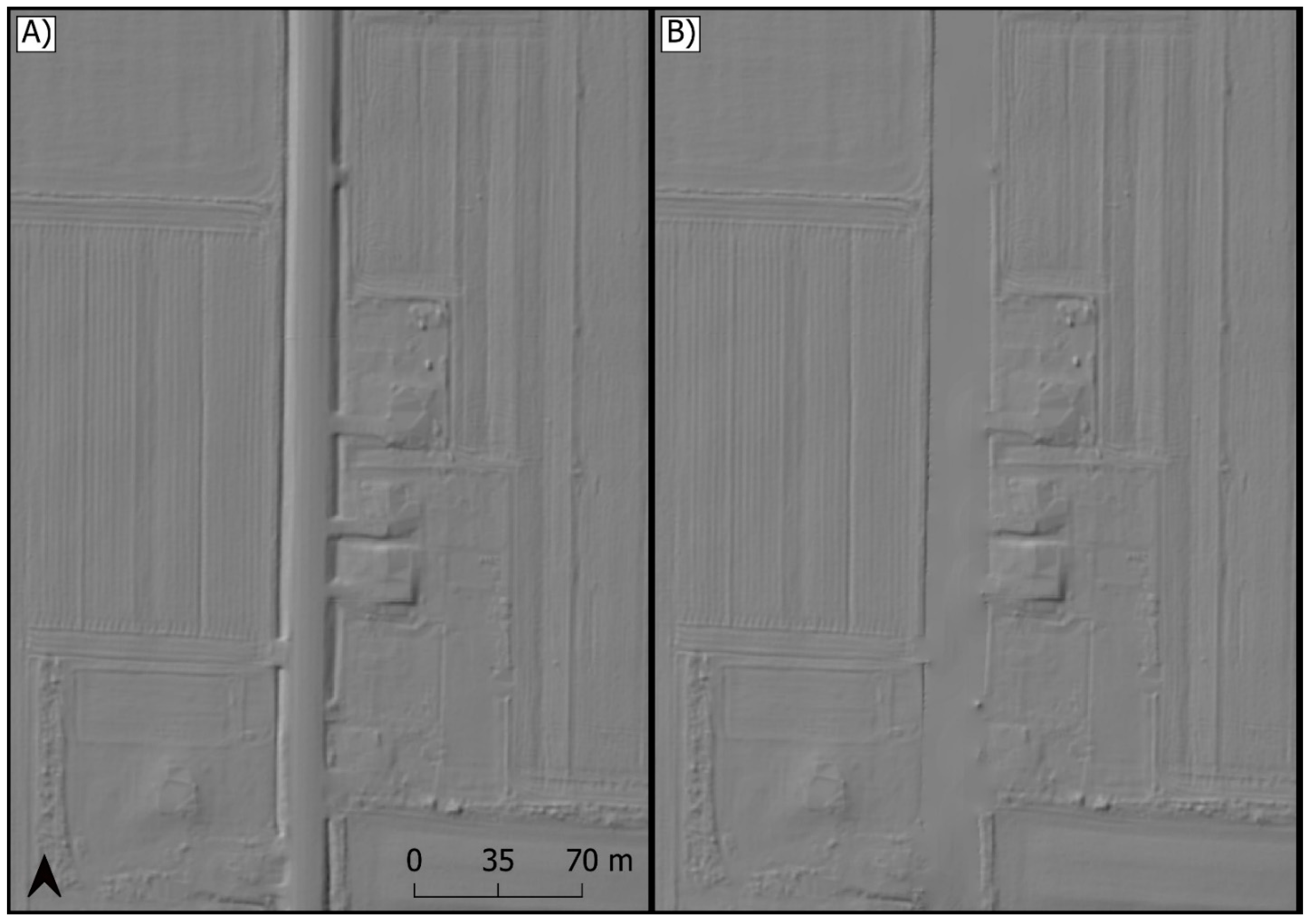
| Parameter | Description |
|---|---|
| Seed repositioning search distance | Size of the neighbourhood to search around each transportation network cell |
| Minimum road width | Width of the top of the level road or railway surface |
| Typical embankment width | Maximum width of a ditch-lined embankment |
| Maximum embankment width | Maximum width of an embankment at a valley crossing |
| Maximum typical embankment height | Maximum height of a ditch-lined embankment |
| Maximum upward elevation increment | Maximum elevation the embankment region is allowed to grow upwards |
| Spill-out slope | Threshold for the maximum absolute slope between a cell and its nearest seed |
| Study Site | Size (Grid Cells) | Relief (m) | Road/Rail Length (km) |
|---|---|---|---|
| Catfish 1 | 42,636,000 | 32.35 | 21.57 |
| Catfish 2 | 69,435,000 | 20.43 | 33.53 |
| Brantford 1 | 19,791,000 | 24.33 | 10.52 |
| Brantford 2 | 78,334,000 | 38.15 | 46.47 |
| Kettle 1 | 76,184,000 | 45.11 | 26.23 |
| Kettle 2 | 134,723,000 | 49.97 | 69.22 |
| McGregor 1 | 16,880,000 | 16.16 | 16.01 |
| McGregor 2 | 42,636,000 | 21.16 | 32.89 |
| Study Site | SrchDist | MinWidth | TypWidth | MaxWidth | MaxHght | ElevInc | SpillSlope |
|---|---|---|---|---|---|---|---|
| Catfish 1 | 10.0 | 4.0 | 15.0 | 35.0 | 1.0 | 0.005 | 2.0 |
| Catfish 2 | 10.0 | 5.0 | 15.0 | 25.0 | 1.0 | 0.005 | 4.0 |
| Brantford 1 | 5.0 | 5.0 | 15.0 | 30.0 | 1.0 | 0.005 | 4.0 |
| Brantford 2 | 5.0 | 6.0 | 25.0 | 35.0 | 1.0 | 0.05 | 6.0 |
| Kettle 1 | 5.0 | 6.0 | 25.0 | 40.0 | 1.0 | 0.05 | 4.0 |
| Kettle 2 | 3.0 | 6.0 | 25.0 | 40.0 | 2.0 | 0.05 | 4.0 |
| McGregor 1 | 15.0 | 2.0 | 20.0 | 40.0 | 2.0 | 0.05 | 4.0 |
| McGregor 2 | 8.0 | 4.0 | 20.0 | 35.0 | 2.0 | 0.05 | 4.0 |
| Study Site | Processing Time (s) | Recall (%) | Precision (%) | PPC |
|---|---|---|---|---|
| Catfish 1 | 4.6 | 90.4 | 70.7 | 0.792 |
| Catfish 2 | 6.3 | 94.0 | 81.8 | 0.873 |
| Brantford 1 | 1.4 | 90.3 | 75.5 | 0.820 |
| Brantford 2 | 12.5 | 90.0 | 70.3 | 0.786 |
| Kettle 1 | 6.6 | 87.3 | 67.3 | 0.760 |
| Kettle 2 | 20.3 | 91.8 | 78.8 | 0.841 |
| McGregor 1 | 2.6 | 96.5 | 78.1 | 0.859 |
| McGregor 2 | 7.8 | 93.6 | 80.3 | 0.862 |
Publisher’s Note: MDPI stays neutral with regard to jurisdictional claims in published maps and institutional affiliations. |
© 2021 by the authors. Licensee MDPI, Basel, Switzerland. This article is an open access article distributed under the terms and conditions of the Creative Commons Attribution (CC BY) license (http://creativecommons.org/licenses/by/4.0/).
Share and Cite
Van Nieuwenhuizen, N.; Lindsay, J.B.; DeVries, B. Automated Mapping of Transportation Embankments in Fine-Resolution LiDAR DEMs. Remote Sens. 2021, 13, 1308. https://doi.org/10.3390/rs13071308
Van Nieuwenhuizen N, Lindsay JB, DeVries B. Automated Mapping of Transportation Embankments in Fine-Resolution LiDAR DEMs. Remote Sensing. 2021; 13(7):1308. https://doi.org/10.3390/rs13071308
Chicago/Turabian StyleVan Nieuwenhuizen, Nigel, John B. Lindsay, and Ben DeVries. 2021. "Automated Mapping of Transportation Embankments in Fine-Resolution LiDAR DEMs" Remote Sensing 13, no. 7: 1308. https://doi.org/10.3390/rs13071308
APA StyleVan Nieuwenhuizen, N., Lindsay, J. B., & DeVries, B. (2021). Automated Mapping of Transportation Embankments in Fine-Resolution LiDAR DEMs. Remote Sensing, 13(7), 1308. https://doi.org/10.3390/rs13071308






